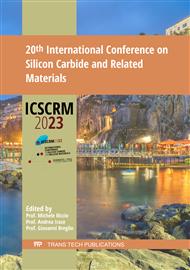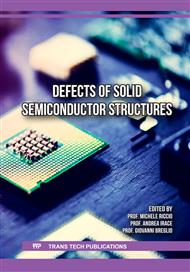p.33
p.39
p.45
p.51
p.61
p.67
p.71
p.81
p.87
Emission of Trapped Electrons from the 4H-SiC/SiO2-Interface via Photon-Irradiance at Cryogenic Temperatures
Abstract:
For a reliable MOSFET performance it is crucial to identify and reduce device performance limiting 4H-SiC/SiO2 interface defects. Previous studies have focused on the quantification of the interface states density, however, the atomic defect structure is still to be investigated. Here, we introduce a new approach based on opto-electrical measurements, which allow to determine the energetic position of interface defects. The measurement routine is performed at cryogenic temperatures to suppress the thermal emission of electrons, which were trapped at interface states during the cooldown processed (from 300 K to 15 K) while a positive gate voltage of 50 V was applied. At 15 K the photon-assisted emission of trapped electrons is measured in dependence on the photon’s energy (1.8 eV-3 eV). The reduction of the threshold voltage is taken as an indicator for the amount of released charges after each photon irradiation. We found an enhanced emission efficiency at certain photon energies, especially at 2.8 eV. Near-interface-traps (NITs), reported by Afanasev et al. are located close to the measuredtrap level with ENIT = EC, SiO2−2.77(5) eV. Recently, El-Sayed et al. suggested wide-angle O-Si-Obonds as defect configuration, that act as electron traps and have a similar energy as the measure traplevel.
Info:
Periodical:
Pages:
61-66
Citation:
Online since:
August 2024
Authors:
Permissions:
Share:
Citation:



